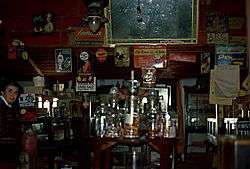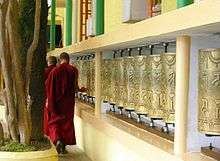McLeod Ganj
| McLeod Ganj मकलाॅड गंज McLeodGanj, McLeodganj, Mcllo | |
|---|---|
| suburb | |
|
View of McLeod Ganj town | |
| Nickname(s): Little Lhasa, or Dhasa | |
 McLeod Ganj  McLeod Ganj Location in Himachal Pradesh, India | |
| Coordinates: 32°14′19″N 76°19′26″E / 32.238602°N 76.323878°ECoordinates: 32°14′19″N 76°19′26″E / 32.238602°N 76.323878°E | |
| Country |
|
| State | Himachal Pradesh |
| District | Kangra |
| Elevation | 2,082 m (6,831 ft) |
| Population | |
| • Total | 11,000 (approx) |
| Languages | |
| • Official | Hindi |
| • Other | English, Tibetan, Pahari |
| Time zone | IST (UTC+5:30) |
| PIN | 176219 |
| Telephone code | 01892 |
McLeod Ganj (also spelt McLeodGanj or Mcleodganj) is a suburb of Dharamshala in Kangra district of Himachal Pradesh, India. It is known as "Little Lhasa" or "Dhasa" (a short form of Dharamshala used mainly by Tibetans) because of its large population of Tibetans.[1] The Tibetan government-in-exile is headquartered in McLeod Ganj.
It has an average elevation of 2,082 metres (6,831 feet). It is situated on the Dhauladhar Range, whose highest peak, "Hanuman Ka Tibba", at about 5,639 metres (18,500 feet), lies just behind it.
Etymology
McLeod Ganj was named after Sir Donald Friell McLeod, a Lieutenant Governor of Punjab; the suffix ganj is a common Hindi-Urdu word for "neighbourhood".[2][3]
History

In March 1850, the area was annexed by the British after the Second Anglo-Sikh War, and soon a subsidiary cantonment for the troops stationed at Kangra was established on the slopes of Dhauladhar, on empty land, with a Hindu resthouse or dharamshala; hence the name for the new cantonment, Dharamshala. During the British rule in India, the town was a hill station where the British spent hot summers, and around the late 1840s, when the district headquarters in Kangra became overcrowded, the British moved two regiments to Dharamshala. A cantonment was established in 1849, and in 1852 Dharamshala became the administrative capital of Kangra district. By 1855 it had two important places of civilian settlement, McLeod Ganj and Forsyth Ganj, named after a Divisional Commissioner.[4] In 1860, the 66th Gurkha Light Infantry, later renamed the historic 1st Gurkha Rifles, was moved to Dharamshala. Soon 14 Gurkha paltan villages were established nearby and the Gurkhas patronised the ancient Shiva temple of Bhagsunath.
Lord Elgin, the British Viceroy of India (1862–63), liked the area so much that at one point he suggested it be made the summer capital of India. He died at Dharamshala while on a tour there, on 20 November 1863, and lies buried at the St. John in the Wilderness at Forsyth Ganj, just below McLeod Ganj.[4] His summer residence, Mortimer House, became part of the private estate of Lala Basheshar Nath of Lahore and was acquired by the Government of India to house the official residence of the Dalai Lama. The original Tea House built by Lord Elgin and catered to by a local grocery store called Nowrojee & Son continues to prosper to this date as a hangout for visitors to McLeodGanj.
The twin towns of Forsyth Ganj and McLeod Ganj continued to grow steadily in the coming years, and by 1904 had become important centres of trade, commerce and official work of Kangra District. But much of the town was destroyed by the devastating 7.8 magnitude 1905 Kangra earthquake at 6:19 am 4 April 1905; close to 19,800 people were killed and thousands were injured in the Kangra area. The earthquake destroyed most buildings in Kangra, Dharamshala, and McLeod Ganj; even the Bhagsunath Temple was destroyed.[5] Thereafter, district headquarters were shifted to a lower spot, and the town waited another half century before anything significant transpired in its history.[6][7]
In March 1959, Tenzin Gyatso, the 14th Dalai Lama, fled to India after the failed uprising in 1959 in Tibet against the Communist Party of China. The Indian Government offered him refuge in Dharamshala, where he set up the Government of Tibet in exile in 1960, while McLeod Ganj became his official residence and also home to several Buddhist monasteries and thousands of Tibetan refugees.[8] Over the years, McLeod Ganj evolved into an important tourist and pilgrimage destination, and has since grown substantially in population.
McLeod Ganj got its own website in 2013, according to a Times of India report.[9]
Transport
- Air
- The nearest airport is Gaggal Airport, 15 km from Dharamshala.
- Rail
- The nearest railway stations on the narrow-gauge Kangra Valley Railway line are at Kangra and Nagrota (about 20 km south of Dharamshala). The nearest railhead (broad gauge) is at Pathankot (85 km).
Tourism


Tourism is an important industry in McLeod Ganj, but many people come here to study Tibetan Buddhism, culture, crafts, etc. The town is also known for Tibetan handicrafts, thangkas, Tibetan carpets, garments and other souvenirs.
Tibetan sites
The most important Buddhist site in the town is Tsuglagkhang or Tsuglag Khang, the Dalai Lama's temple. It has statues of Shakyamuni, Avalokiteśvara, and a statue of Padmasambhava (Guru Rinpoche).
Other Buddhist and Tibetan sites in McLeod Ganj include the Namgyal Monastery, the Tibetan Institute of Performing Arts,[10] Gompa Dip Tse-Chok Ling (a small monastery), the Library of Tibetan Works and Archives, Gangchen Kyishong (called Gangkyi for short by Tibetans and the premises of the Tibetan government-in-exile), Mani Lakhang Stupa, Nechung Monastery, and Norbulingka Institute, which is 8 kilometres away. The 17th Karmapa, Ogyen Trinley Dorje, lives near Dharamshala, in Gyuto monastery in Sidhbari.
Dharamshala International Film Festival (DIFF)
The Dharamshala International Film Festival (DIFF) debuted in McLeod Ganj during the first four days of November 2012, showing recent Indian and world cinema, including fiction, documentaries and shorts. Panel discussions and master classes with filmmakers from India and abroad also took place. DIFF was presented by White Crane Arts & Media trust, established by filmmakers Ritu Sarin and Tenzing Sonam to promote contemporary art, cinema and independent media practices in the Himalayan region.
Other places
The major towns near McLeod Ganj include Dharamshala, Palampur, Kangra, [[Sidhbari]], Tatwani and Machhrial. Other nearby spiritual attractions include Chinmaya Tapovan (a Hindu retreat centre), Osho Nisarga (an Osho retreat centre), and Chamunda (a pilgrimage place for Hindus). Other tourist spots include:

- Triund Hill
- Triund is a ridge that overlooks the Dhauladhars. The ridge elevation is between 2,810 and 2,875 metres. It is a one-day trek 10 kilometres (one way) from McLeod Ganj bus stand and under 6 kilometres (one way) from Galu temple near Dharamkot. The trail is rocky and cut in steps at some places. From Galu temple the trail starts as a gentle ascent to Magic View café. After the café, the ascent is a tad steeper, finally culminating in a steep one-kilometre stretch through a forest of deodars and rhododendron. This stretch through the woods is known as 22 Curves, because of the 22 switchbacks one has to walk through to reach Triund.
- St. John in the Wilderness
- An Anglican church located in the forest near Forsyth Ganj. The neo-Gothic stone building was constructed in 1852. The site also has an old graveyard and a memorial to the British Viceroy Lord Elgin. The church is also noted for its Belgian stained-glass windows, donated by Lady Elgin.
- Dal Lake
- A small lake located about 3 km from McLeod Ganj, next to one of the Tibetan Children's Villages schools. An annual fair is held there in August or September, attended mainly by the Gaddi Community. There is a small spring and an old temple near the lake.
- Bhagsu Nath
- An area 10 minutes' rickshaw ride from McLeod Ganj, particularly popular with Israeli tourists after their compulsory military service. The area has roughly 1,200 local Indians.
Gallery
 Himalayan View, McLeod Ganj
Himalayan View, McLeod Ganj Evening Beauty from Triund Base Camp, McLeod Ganj
Evening Beauty from Triund Base Camp, McLeod Ganj Stupa and prayer wheels. Main street, McLeod Ganj
Stupa and prayer wheels. Main street, McLeod Ganj Main Street, McLeod Ganj
Main Street, McLeod Ganj Bhagsu water fall, McLeod Ganj.
Bhagsu water fall, McLeod Ganj. Moon Light Cafe, McLeod Ganj.
Moon Light Cafe, McLeod Ganj. View of McLeodGanj, winter, 2005.
View of McLeodGanj, winter, 2005. Bhagsu's Waterfall, McLeod Ganj, Dharamshala
Bhagsu's Waterfall, McLeod Ganj, Dharamshala View of Dharamshala from Magic View Cafe
View of Dharamshala from Magic View Cafe Himalayan View, McLeod Ganj
Himalayan View, McLeod Ganj
Notes and references
- ↑ Diehl, Keila (2002). Echoes from Dharamshala Music in the Life of a Tibetan. University of California Press. pp. 45–46. ISBN 978-0-585-46878-5. OCLC 52996458.
- ↑ Dharamshala The Imperial Gazetteer of India, v. 11, p. 301.
- ↑ Experiment in Exile TIME Asia.
- 1 2 History Kangra district Official website.
- ↑ Dharamshala Earthquake 1905 - Images
- ↑ Where the Dalai Lama Dwells New York Times, 29 April 1990.
- ↑ McLeod Ganj
- ↑ www.mcllo.com A Non-Profit Informative, Travel and Community website of Dharamshala, McLeod Ganj and Kangra Valley
- ↑ TIC closed down, tourists left in the lurch, Times of India website, 19 July 2013.
- ↑ "Tibetan Institute of Performing Arts (TIPA)". Planning Commission NGO Database. Planning Commission, Government of India. Retrieved 2007-12-19.
External links
| Wikimedia Commons has media related to McLeod Ganj. |
-
 McLeod Ganj travel guide from Wikivoyage
McLeod Ganj travel guide from Wikivoyage - A Guide to Little Lhasa in India Government of Tibet in Exile website.
